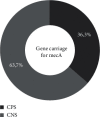Antibiotic Resistance Profiling of Pathogenic Staphylococcus Species from Urinary Tract Infection Patients in Benin
- PMID: 37223336
- PMCID: PMC10202603
- DOI: 10.1155/2023/6364128
Antibiotic Resistance Profiling of Pathogenic Staphylococcus Species from Urinary Tract Infection Patients in Benin
Abstract
Staphylococci can cause urinary tract infections (UTIs). These UTIs are among the significant causes of antibiotic resistance and the spread of antibiotic-resistant diseases. The current study is aimed at establishing a resistance profile and determining the pathogenicity of Staphylococcus strains isolated from UTI samples collected in Benin. For this purpose, urine samples (one hundred and seventy) that were collected from clinics and hospitals showed UTI in patients admitted/visited in Benin. The biochemical assay method was used to identify Staphylococcus spp., and the disk diffusion method tested the antimicrobial susceptibility. The biofilm formation ability of the isolates of Staphylococcus spp. was investigated by the colorimetric method. The presence of mecA, edinB, edinC, cna, bbp, and ebp genes was examined by multiplex polymerase chain reaction (PCR). The results showed that Staphylococcus species were identified in 15.29% of all infected individuals and that 58% of these strains formed biofilms. Most Staphylococcus strains (80.76%) were isolated in female samples, and the age group below 30 years appeared to be the most affected, with a rate of 50%. All Staphylococcus strains isolated were 100% resistant to penicillin and oxacillin. The lowest resistance rates were seen with ciprofloxacin (30.8%), gentamicin, and amikacin (26.90%). Amikacin was the best antibiotic against Staphylococcus strains isolated from UTIs. The isolates carried mecA (42.31%), bbp (19.23%), and ebp (26.92%) genes in varying proportions. This study provides new information on the risks posed to the population by the overuse of antibiotics. In addition, it will play an essential role in restoring people's public health and controlling the spread of antibiotic resistance in urinary tract infections in Benin.
Copyright © 2023 Funkè F. Assouma et al.
Conflict of interest statement
The authors declare no conflicts of interest.
Figures








References
-
- Dougnon V., Assogba P., Mohammed J., et al. Urinary tract infections in Benin: exploring the virulence factors and antibiotic resistance and virulence genes among bacterial isolates. International Journal of Pathogen Research . 2021;7(1):28–36. doi: 10.9734/ijpr/2021/v7i130174. - DOI
MeSH terms
Substances
LinkOut - more resources
Full Text Sources
Medical
Miscellaneous

